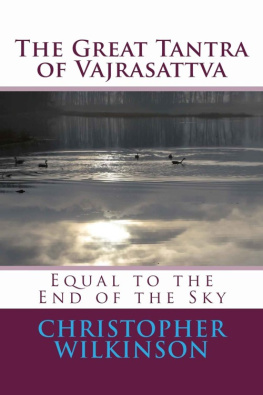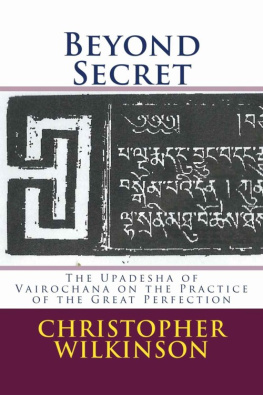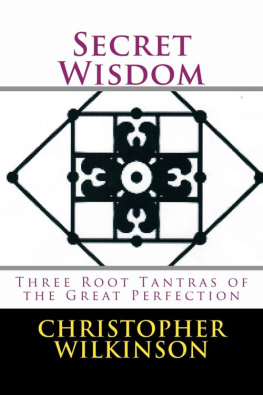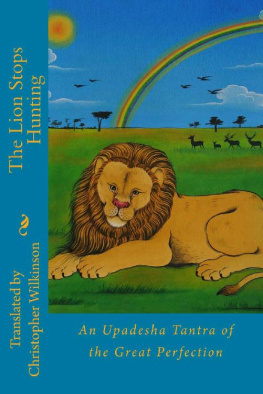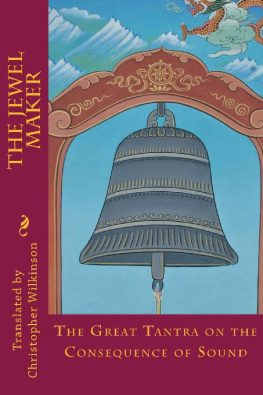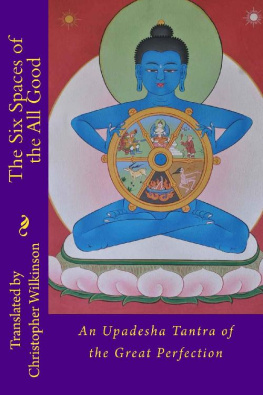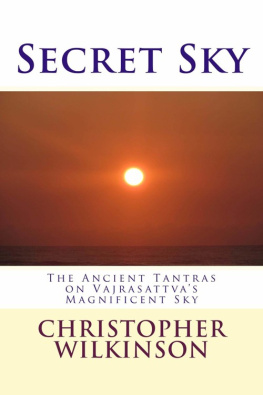The Great Tantra of Vajrasattva Equal to the End of the Sky Translated by Christopher Wilkinson 2015 No part of this book may be reproduced in any form or by any electronic or mechanical means including information storage and retrieval systems, without permission in writing from the author. The only exception is by a reviewer, who may quote excerpts in a review. Published by Christopher Wilkinson Cambridge, MA, USA Copyright 2015 Christopher Wilkinson All rights reserved. ISBN: 1508526184 ISBN-13: 978-1508526186 Also translated by Christopher Wilkinson Secret Wisdom: Three Root Tantras of the Great Perfection Beyond Wisdom: The Upadesha of Vairochana on the Practice of the Great Perfection The Sakya Kongma Series: Sakya Panditas Poetic Wisdom Jetsun Dragpa Gyaltsan: The Hermit King Admission at Dharmas Gates by Sonam Tsemo An Overview of Tantra and Related Works Chogyal Phagpa: The Emperors Guru Contents DEDICATION To my mother, Joyce Lindsay. Live long and prosper. ACKNOWLEDGMENTS First and foremost, I wish to thank my root teacher Dezhung Rinpoche for constantly bringing out the best in me and encouraging me to pursue a comprehension of every branch of Buddhist learning.
It was he who introduced me to Dilgo Kyentse Rinpoche, and through his recommendations enabled me to receive full empowerments, transmissions, and permissions in the areas of Mah, Anu, and Ati Yogas. With the highest regard I wish to thank Dilgo Kyentse Rinpoche, Khetsun Zangpo Rinpoche, and Khenpo Palden Sherab for their kind instruction and encouragement in my effort to translate the literature of the rDzogs chen. There are many individuals, too many to name here, that have helped me over the years to become a qualified translator, in many ways. At this time I want to remember the kindness of Ngawang Kunga Trinlay Sakyapa, Dhongthog Rinpoche, H.H. Karmapa Rangjung Rigpay Dorje, Kalu Rinpoche, Chogyam Trungpa Rinpoche, Geshe Ngawang Nornang, David Ruegg, Turrell Wylie, Gene Smith, Karen Lang, Richard Solomon, Jack Hawley, David Jackson, Cyrus Stearns, Herbert Guenther, Eva Neumeier-Dargyay, Leslie Kawamura, Robert Thurman, Paul Nietupski, Lou Lancaster, David Snellgrove, Jean-Luc Achard, Steve Landsberg, Moke Mokotoff, Tsultrim Alione, Carolyn Klein, Rob Mayer, Jonathan Silk, David White, Mark Tatz, Steve Goodman, and Kennard Lipman. I want to make special thanks to Sarah Moosvi and Otavio Lilla for proofing the manuscript.
The many people who have contributed to my understanding and ability to do this work cannot be counted. I wish to thank everyone that has taken a kind interest in these translations, however slight, for your part in making this work a reality. .
Introduction
As a young child, Vairochana was one of seven select Tibetan children that had been singled out for intensive training in foreign languages by the King Trisong Detsan, who ruled from 755 to 804 AD. As a young man, the King endowed him with a large amount of gold and sent him to India in search of special teachings, the transmission of effortless enlightenment. Travelling with only one friend, Vairochana underwent tremendous hardships to get to India and find a qualified teacher of this transmission.
At last he found r Singha, who was a qualified teacher of this transmission, but did not have the books. The King had sealed the volumes that contained this teaching in Bodhgaya, and locked them up. So r Singha and Vairochana snuck in by night, broke the seals, and stole the books, without being noticed. Then, in a place called Dhahena, r Singha taught these texts to Vairochana secretly, in the middle of the night. Vairochanas biography, The Great Image, The other is The Great Tantra of Vajrasattva: Equal to the End of the Sky. The existence of these texts shows us that Vairochana was working very hard as a translator, even while in India, and that he had a least a few translations ready for presentation when he arrived back in Tibet.
It also indicates that the Great Tantra of Vajrasattva may well have been one of the earliest major translations of a Great Perfection Tantra into Tibetan. In Tibet, the Yamantaka Sadhana was preserved in the Tengyur, the official compilation of commentarial texts, but the Great Tantra of Vajrasattva was not included in the Kagyur, the official compilation of the Buddhas own teachings. We may wonder why it was not included. The Great Tantra of Vajrasattva appears to be a Buddhist work. It talks about Buddhas, Bodhisattvas, and enlightenment, in the style of a Sutra or a Tantra, but as we read we will see that it uses language that is unusual for a Buddhist work. It talks about unity in non-duality, oneness, the lack of any need to practice a path, and the irrelevance of cause and result, for example.
It talks about a self-luminescent wisdom that is eternal. The existence of books that resemble the Dharma, but actually contain unorthodox teachings, was noted heavily by the leaders of the reformation movements of the Eleventh Century, collectively known as the New Schools (Sarma). Podrang Zhiwa Od compiled a list of such scriptures in the 11 th century, calling them contrived semblances ( ltar bcos ). The Great Tantra of Vajrasattva is not on his list. I have found no citation of this work as having been deliberately excluded from the Kagyur. Whether it was not available to the compilers or its contents were found objectionable will require further research.
A study of the possible origin of the Great Tantra of Vajrasattva is beyond the scope of this introduction. Readers who are familiar with world literature may well see evidence of Gnostic teachings in reading this. Clear evidence of Gnosis movements along the Silk Route has been documented. Some may see evidence of the Upan i adic thought that informed the Advaita tradition reflected here in Buddhistic terminology. It is possible that some writer had a deliberate intention of subterfuge, intending to trick unwary Buddhists into accepting non-Buddhist views, but it would likely have been disseminated more widely if this were so. Those who seek evidence that Buddhist and non-Buddhist thinking had reached the point, by the Eighth Century, that they were sometimes indistinguishable may find evidence of this in this Tantra.
It may well be that the Great Tantra of Vajrasattva was considered to represent heterodox views by some Tibetans, and therefore excluded from the Kagyur. Many who persevere at maintaining orthodoxy fail to remember that the orthodox can only be understood in its relation to the heterodox. We will better understand Buddhist orthodoxy by reading a text that represents what it tries to guard against. The Great Tantra of Vajrasattva itself claims that a few fortunate people may achieve instantaneous enlightenment by understanding its contents. I hope so. While the Great Tantra of Vajrasattva was not incorporated into the Kagyur, its manuscript was faithfully copied down through the centuries, preserved among the collections called Nyingma Gyubum, or Hundred Thousand Tantras of the Ancients and in the manuscript collection known as the Hundred Thousand Tantras of Vairochana.
The Great Tantra of Vajrasattva is only one of a very many scriptures translated by Vairochana. I hope that this translation will encourage further study of the literature of the Great Perfection tradition, so that these treasures of mankinds literary heritage may be more widely read and appreciated.
The Great Tantra of Vajrasattva
Equal to the End of the Sky
In the Indian language: Vajrasatva Khasam Anta Mahtantra In the Tibetan language: rDo rje sems dpa nam mkhai mtha dang mnyam pai rgyud chen po In the English language: The Great Tantra of Vajrasattva: Equal to the End of the Sky
The Basic Scene
I bow to glorious Vajrasattva, Secret Wisdom! These things were once spoken: The Tathagata is a fully perfected Buddha who dwells eternally in a magnificent pleasure that is like the sky. His body, speech, and mind are like vajras. He is a spontaneously formed potentate, indivisible from the totality of Vajrasattvas. He beams out like a thousand suns in a most extraordinary way.

